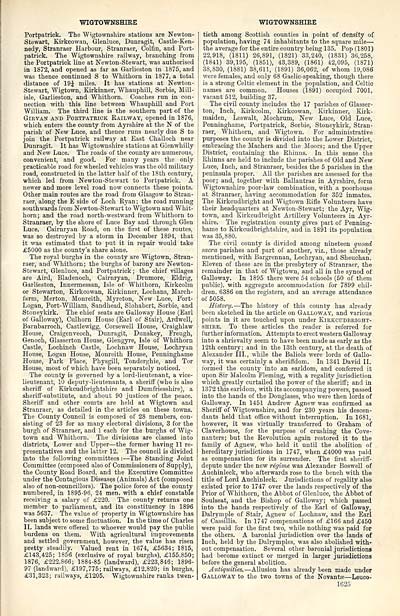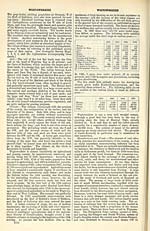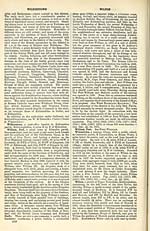Ordnance gazetteer of Scotland
(1633) Page 1625
Download files
Complete book:
Individual page:
Thumbnail gallery: Grid view | List view

WIGTOWNSHIRE
Portpatrick. The Wigtownshire stations are Newton-
Stewart, Kirkcowan, Glenluce, Dunragit, Castle-Ken-
nedy, Stranraer Harbour, Stranraer, Colfin, and Port-
patrick. The Wigtownshire railway, branching from
the Portpatrick line at Newton-Stewart, was authorised
in 1872, and opened as far as Garlieston in 1875, and
was thence continued S to Whithorn in 1877, a total
distance of 19J miles. It has stations at Newton-
Stewart, Wigtown, Kirkinner, Whauphill, Sorbie, Mill-
isle, Garlieston, and Whithorn. Coaches run in con-
nection with this line between Whauphill and Port
William. The third line is the southern part of the
Girvan and Portpatrick Kailwat, opened in 1876,
which enters the county from Ayrshire at the N of the
parish of New Luce, and thence runs nearly due S to
join the Portpatrick railway at East Challoeh near
Dunragit. It has Wigtownshire stations at Glenwhilly
and New Luce. The roads of the county are numerous,
convenient, and good. For many years the only
practicable road for wheeled vehicles was the old military
road, constructed in the latter half of the 18th century,
which led from Newton-Stewart to Portpatrick. A
newer and more level road now connects these points.
Other main routes are the road from Glasgow to Stran-
raer, along the E side of Loch Ryan ; the road running
southwards from Newton-Stewart to Wigtown and Whit-
horn; and the road north-westward from Whithorn to
Stranraer, by the shore of Luce Bay and through Glen
Luce. Cairnryan Road, on the first of these routes,
was so destroyed by a storm in December 1894, that
it was estimated that to put it in repair would take
£5000 as the county's share alone.
The royal burghs in the county are Wigtown, Stran-
raer, and Whithorn; the burghs of barony are Newton-
Stewart, Glenluce, and Portpatrick ; the chief villages
are Aird, Bladenoch, Cairnryan, Drumore, Eldrig,
Garlieston, Innermessan, Isle of Whithorn, Kirkcolm
or Stewarton, Kirkcowan, Kirkinner, Lochans, March-
farm, Merton, Monreith, Myreton, New Luce, Port-
Logan, Port- William, Sandhead, Slohabert, Sorbie, and
Stoneykirk. The chief seats are Galloway House (Earl
of Galloway), Culhorn House (Earl of Stair), Ardwell,
Barnbarroch, Castlewigg, Corsewell House, Craighlaw
House, Craigenveoch, Dunragit, Dunskey, Freugh,
Genoch, Glasserton House, Glengyre, Isle of Whithorn
Castle, Lochinch Castle, Lochnaw House, Lochryan
House, Logan House, Monreith House, Penninghame
House, Park Place, Physgill, Tonderghie, and Tor
House, most of which have been separately noticed.
The county is governed by a lord-lieutenant, a vice-
lieutenant, 10 deputy-lieutenants, a sheriff (who is also
sheriff of Kirkcudbrightshire and Dumfriesshire), a
sheriff-substitute, and about 90 justices of the peace.
Sheriff and other courts are held at Wigtown and
Stranraer, as detailed in the articles on these towns.
The County Council is composed of 28 members, con-
sisting of 23 for as many electoral divisions, 3 for the
burgh of Stranraer, and 1 each for the burghs of Wig-
town and Whithorn. The divisions are classed into
districts, Lower and Upper — the former having 11 re-
presentatives and the latter 12. The council is divided
into the following committees : — The Standing Joint
Committee (composed also of Commissioners of Supply),
the County Road Board, and the Executive Committee
under the Contagious Diseases (Animals) Act (composed
also of non-councillors). The police force of the county
numbered, in 1895-96, 24 men, with a chief constable
receiving a salary of £220. The county returns one
member to parliament, and its constituency in 1896
was 5637. The value of property in Wigtownshire has
been subject to some fluctuation. In the time of Charles
II. lands were offered to whoever would pay the public
burdens on them. With agricultural improvements
and settled government, however, the value has risen
pretty steadily. Valued rent in 1674, £5634; 1815,
£143,425; 1856 (exclusive of royal burghs), £155,850;
1876, £222,866; 1884-85 (landward), £223,846; 1896-
97 (landward), £197,775; railways, £12,820; in burghs,
£31,323; railways, £1205. Wigtownshire ranks twen-
WIGTOWNSHIRE
tieth among Scottish counties in point of density of
population, having 74 inhabitants to the square mile —
the average for the entire country being 135. Pop (1801)
22,918, (1811) 26,891, (1821) 33,240, (1831) 36,258,
(1841) 39,195, (1851), 43,389, (1861) 42,095, (1871)
38,830, (1881) 38,611, (1891) 36,062, of whom 19,086
were females, and only 68 Gaelic-speaking, though there
is a strong Celtic elemeut in the population, and Celtic
names are common. Houses (1891) occupied 7001,
vacant 512, building 37.
The civil county includes the 17 parishes of Glasser-
ton, Inch, Kirkcolm, Kirkcowan, Kirkinner, Kirk-
maiden, Leswalt, Mochrum, New Luce, Old Luce,
Penninghame, Portpatrick, Sorbie, Stoneykirk, Stran-
raer, Whithorn, and Wigtown. Por administrative
purposes the county is divided into the Lower District,
embracing the Machers and the Moors; and the Upper
District, containing the Rhinns. In this sense the
Rhinns are held to include the parishes of Old and New
Luce, Inch, and Stranraer, besides the 5 parishes in the
peninsula proper. All the parishes are assessed for the
poor; and, together with Ballantrae in Ayrshire, form
Wigtownshire poor-law combination, with a poorhouse
at Stranraer, having accommodation for 352 inmates.
The Kirkcudbright and Wigtown Rifle Volunteers have
their headquarters at Newton-Stewart; the Ayr, Wig-
town, and Kirkcudbright Artillery Volunteers in Ayr-
shire. The registration county gives part of Penning-
hame to Kirkcudbrightshire, and in 1891 its population
was 35,880.
The civil county is divided among nineteen quoad
sacra parishes and part of another, viz., those already
mentioned, with Bargrennan, Lochryan, and Sheuchan.
Eleven of these are in the presbytery of Stranraer, the
remainder in that of Wigtown, and all in the synod of
Galloway. In 1895 there were 54 schools (50 of them
public), with aggregate accommodation for 7899 chil-
dren, 6386 on the registers, and an average attendance
of 5058.
History. — The history of this county has already
been sketched in the article on Galloway, and various
points in it are touched upon under Kirkcttdbright-
shirb. To these articles the reader is referred for
further information. Attempts to erect western Galloway
into a shrievalty seem to have been made as early as the
12th century; and in the 13th century, at the death of
Alexander III., wliile the Baliols were lords of Gallo-
way, it was certainly a sheriffdom. In 1341 David II.
formed the county into an earldom, and conferred it
upon Sir Malcolm Fleming, with a regality jurisdiction
which greatly curtailed the power of the sheriff; and in
1372 this earldom, with its accompanying powers, passed
into the hands of the Douglases, who were then lords of
Galloway. In 1451 Andrew Agnew was confirmed as
Sheriff of Wigtownshire, and for 230 years his descen-
dants held that office without interruption. In 1681,
however, it was virtually transferred to Graham of
Claverhouse, for the purpose of crushing the Cove-
nanters; but the Revolution again restored it to the
family of Agnew, who held it until the abolition of
hereditary jurisdictions in 1747, when £4000 was paid
as compensation for its surrender. The first sheriff-
depute under the new regime was Alexander Boswell of
Auchinleck, who afterwards rose to the bench with the
title of Lord Auchinleck. Jurisdictions of regality also
existed prior to 1747 over the lands respectively of the
Prior of Whithorn, the Abbot of Glenluce, the Abbot of
Soulseat, and the Bishop of Galloway; which passed
into the hands respectively of the Earl of Galloway,
Dalrymple of Stair, Agnew of Lochnaw, and the Earl
of Cassillis. In 1747 compensations of £166 and £450
were paid for the first two, while nothing was paid for
the others. A baronial jurisdiction over the lands of
Inch, held by the Dalrymples, was also abolished with-
out compensation. Several other baronial jurisdictions
had become extinct or merged in larger jurisdictions
before the general abolition.
Antiquities. — Allusion has already been made under
Galloway to the two towns of the Novantse — Leuco-
1625
Portpatrick. The Wigtownshire stations are Newton-
Stewart, Kirkcowan, Glenluce, Dunragit, Castle-Ken-
nedy, Stranraer Harbour, Stranraer, Colfin, and Port-
patrick. The Wigtownshire railway, branching from
the Portpatrick line at Newton-Stewart, was authorised
in 1872, and opened as far as Garlieston in 1875, and
was thence continued S to Whithorn in 1877, a total
distance of 19J miles. It has stations at Newton-
Stewart, Wigtown, Kirkinner, Whauphill, Sorbie, Mill-
isle, Garlieston, and Whithorn. Coaches run in con-
nection with this line between Whauphill and Port
William. The third line is the southern part of the
Girvan and Portpatrick Kailwat, opened in 1876,
which enters the county from Ayrshire at the N of the
parish of New Luce, and thence runs nearly due S to
join the Portpatrick railway at East Challoeh near
Dunragit. It has Wigtownshire stations at Glenwhilly
and New Luce. The roads of the county are numerous,
convenient, and good. For many years the only
practicable road for wheeled vehicles was the old military
road, constructed in the latter half of the 18th century,
which led from Newton-Stewart to Portpatrick. A
newer and more level road now connects these points.
Other main routes are the road from Glasgow to Stran-
raer, along the E side of Loch Ryan ; the road running
southwards from Newton-Stewart to Wigtown and Whit-
horn; and the road north-westward from Whithorn to
Stranraer, by the shore of Luce Bay and through Glen
Luce. Cairnryan Road, on the first of these routes,
was so destroyed by a storm in December 1894, that
it was estimated that to put it in repair would take
£5000 as the county's share alone.
The royal burghs in the county are Wigtown, Stran-
raer, and Whithorn; the burghs of barony are Newton-
Stewart, Glenluce, and Portpatrick ; the chief villages
are Aird, Bladenoch, Cairnryan, Drumore, Eldrig,
Garlieston, Innermessan, Isle of Whithorn, Kirkcolm
or Stewarton, Kirkcowan, Kirkinner, Lochans, March-
farm, Merton, Monreith, Myreton, New Luce, Port-
Logan, Port- William, Sandhead, Slohabert, Sorbie, and
Stoneykirk. The chief seats are Galloway House (Earl
of Galloway), Culhorn House (Earl of Stair), Ardwell,
Barnbarroch, Castlewigg, Corsewell House, Craighlaw
House, Craigenveoch, Dunragit, Dunskey, Freugh,
Genoch, Glasserton House, Glengyre, Isle of Whithorn
Castle, Lochinch Castle, Lochnaw House, Lochryan
House, Logan House, Monreith House, Penninghame
House, Park Place, Physgill, Tonderghie, and Tor
House, most of which have been separately noticed.
The county is governed by a lord-lieutenant, a vice-
lieutenant, 10 deputy-lieutenants, a sheriff (who is also
sheriff of Kirkcudbrightshire and Dumfriesshire), a
sheriff-substitute, and about 90 justices of the peace.
Sheriff and other courts are held at Wigtown and
Stranraer, as detailed in the articles on these towns.
The County Council is composed of 28 members, con-
sisting of 23 for as many electoral divisions, 3 for the
burgh of Stranraer, and 1 each for the burghs of Wig-
town and Whithorn. The divisions are classed into
districts, Lower and Upper — the former having 11 re-
presentatives and the latter 12. The council is divided
into the following committees : — The Standing Joint
Committee (composed also of Commissioners of Supply),
the County Road Board, and the Executive Committee
under the Contagious Diseases (Animals) Act (composed
also of non-councillors). The police force of the county
numbered, in 1895-96, 24 men, with a chief constable
receiving a salary of £220. The county returns one
member to parliament, and its constituency in 1896
was 5637. The value of property in Wigtownshire has
been subject to some fluctuation. In the time of Charles
II. lands were offered to whoever would pay the public
burdens on them. With agricultural improvements
and settled government, however, the value has risen
pretty steadily. Valued rent in 1674, £5634; 1815,
£143,425; 1856 (exclusive of royal burghs), £155,850;
1876, £222,866; 1884-85 (landward), £223,846; 1896-
97 (landward), £197,775; railways, £12,820; in burghs,
£31,323; railways, £1205. Wigtownshire ranks twen-
WIGTOWNSHIRE
tieth among Scottish counties in point of density of
population, having 74 inhabitants to the square mile —
the average for the entire country being 135. Pop (1801)
22,918, (1811) 26,891, (1821) 33,240, (1831) 36,258,
(1841) 39,195, (1851), 43,389, (1861) 42,095, (1871)
38,830, (1881) 38,611, (1891) 36,062, of whom 19,086
were females, and only 68 Gaelic-speaking, though there
is a strong Celtic elemeut in the population, and Celtic
names are common. Houses (1891) occupied 7001,
vacant 512, building 37.
The civil county includes the 17 parishes of Glasser-
ton, Inch, Kirkcolm, Kirkcowan, Kirkinner, Kirk-
maiden, Leswalt, Mochrum, New Luce, Old Luce,
Penninghame, Portpatrick, Sorbie, Stoneykirk, Stran-
raer, Whithorn, and Wigtown. Por administrative
purposes the county is divided into the Lower District,
embracing the Machers and the Moors; and the Upper
District, containing the Rhinns. In this sense the
Rhinns are held to include the parishes of Old and New
Luce, Inch, and Stranraer, besides the 5 parishes in the
peninsula proper. All the parishes are assessed for the
poor; and, together with Ballantrae in Ayrshire, form
Wigtownshire poor-law combination, with a poorhouse
at Stranraer, having accommodation for 352 inmates.
The Kirkcudbright and Wigtown Rifle Volunteers have
their headquarters at Newton-Stewart; the Ayr, Wig-
town, and Kirkcudbright Artillery Volunteers in Ayr-
shire. The registration county gives part of Penning-
hame to Kirkcudbrightshire, and in 1891 its population
was 35,880.
The civil county is divided among nineteen quoad
sacra parishes and part of another, viz., those already
mentioned, with Bargrennan, Lochryan, and Sheuchan.
Eleven of these are in the presbytery of Stranraer, the
remainder in that of Wigtown, and all in the synod of
Galloway. In 1895 there were 54 schools (50 of them
public), with aggregate accommodation for 7899 chil-
dren, 6386 on the registers, and an average attendance
of 5058.
History. — The history of this county has already
been sketched in the article on Galloway, and various
points in it are touched upon under Kirkcttdbright-
shirb. To these articles the reader is referred for
further information. Attempts to erect western Galloway
into a shrievalty seem to have been made as early as the
12th century; and in the 13th century, at the death of
Alexander III., wliile the Baliols were lords of Gallo-
way, it was certainly a sheriffdom. In 1341 David II.
formed the county into an earldom, and conferred it
upon Sir Malcolm Fleming, with a regality jurisdiction
which greatly curtailed the power of the sheriff; and in
1372 this earldom, with its accompanying powers, passed
into the hands of the Douglases, who were then lords of
Galloway. In 1451 Andrew Agnew was confirmed as
Sheriff of Wigtownshire, and for 230 years his descen-
dants held that office without interruption. In 1681,
however, it was virtually transferred to Graham of
Claverhouse, for the purpose of crushing the Cove-
nanters; but the Revolution again restored it to the
family of Agnew, who held it until the abolition of
hereditary jurisdictions in 1747, when £4000 was paid
as compensation for its surrender. The first sheriff-
depute under the new regime was Alexander Boswell of
Auchinleck, who afterwards rose to the bench with the
title of Lord Auchinleck. Jurisdictions of regality also
existed prior to 1747 over the lands respectively of the
Prior of Whithorn, the Abbot of Glenluce, the Abbot of
Soulseat, and the Bishop of Galloway; which passed
into the hands respectively of the Earl of Galloway,
Dalrymple of Stair, Agnew of Lochnaw, and the Earl
of Cassillis. In 1747 compensations of £166 and £450
were paid for the first two, while nothing was paid for
the others. A baronial jurisdiction over the lands of
Inch, held by the Dalrymples, was also abolished with-
out compensation. Several other baronial jurisdictions
had become extinct or merged in larger jurisdictions
before the general abolition.
Antiquities. — Allusion has already been made under
Galloway to the two towns of the Novantse — Leuco-
1625
Set display mode to: Large image | Transcription
Images and transcriptions on this page, including medium image downloads, may be used under the Creative Commons Attribution 4.0 International Licence unless otherwise stated. ![]()
| Gazetteers of Scotland, 1803-1901 > Ordnance gazetteer of Scotland > (1633) Page 1625 |
|---|
| Permanent URL | https://digital.nls.uk/97412842 |
|---|

